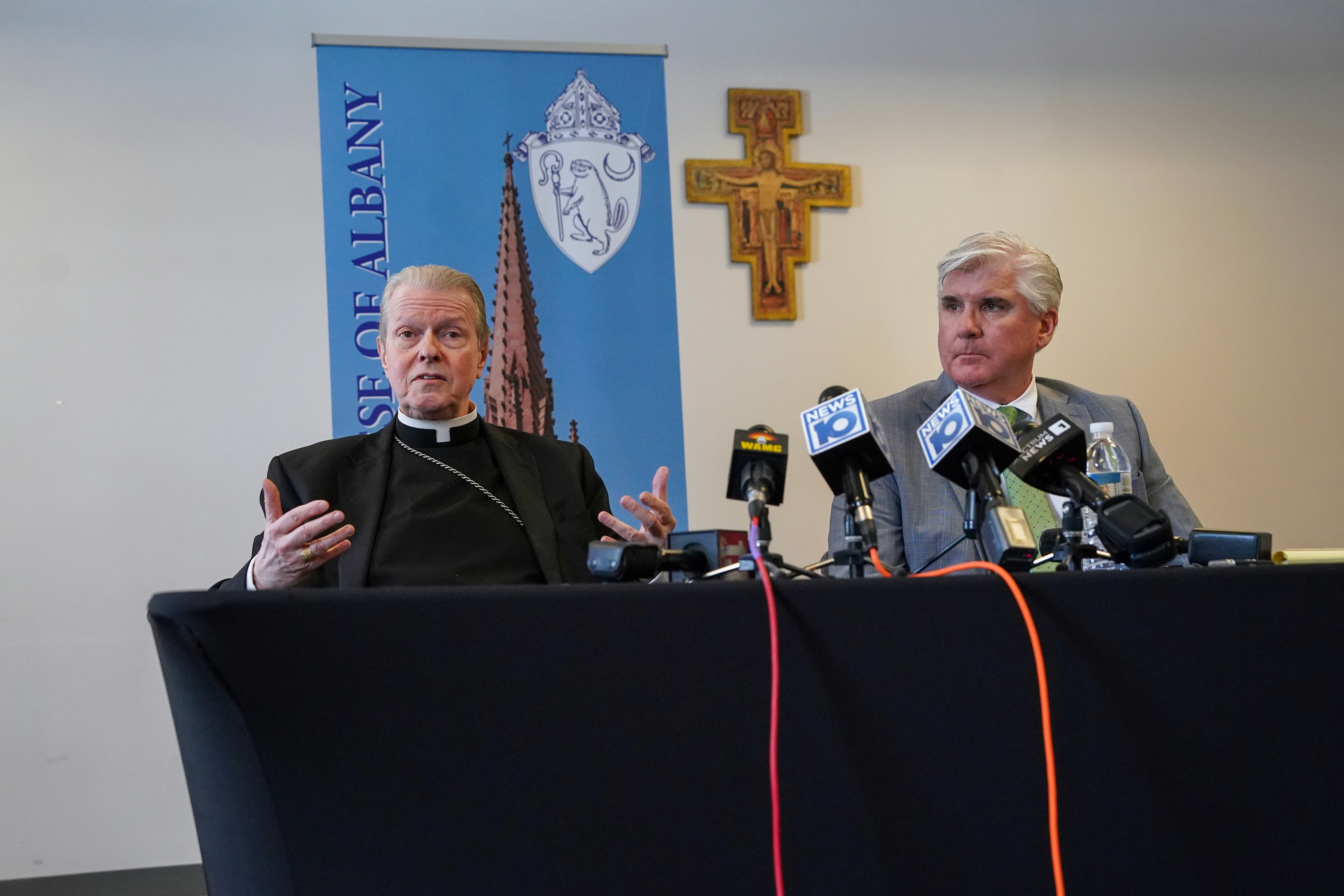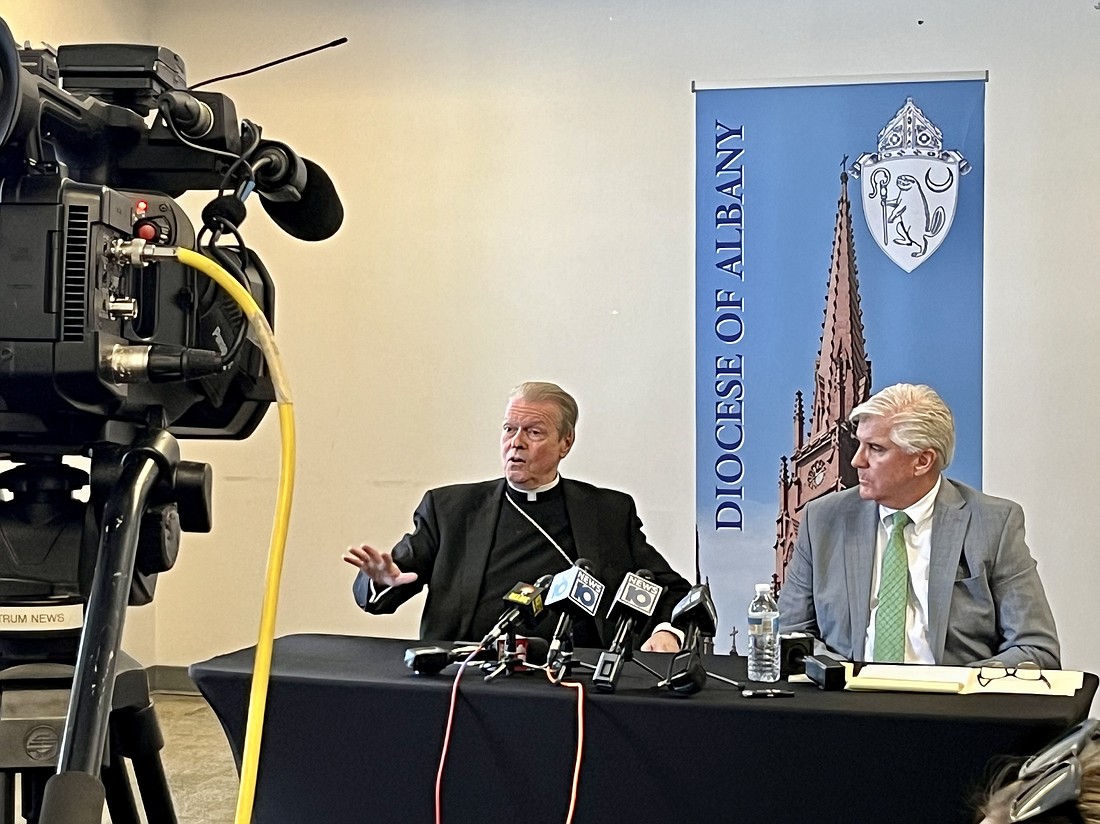March 15, 2023 at 4:22 p.m.
‘WE CAN ... GROW STRONGER TOGETHER’

Saying it was the “best way, at this point, to ensure that all Victim/Survivors with pending CVA litigation will receive some compensation,” the Roman Catholic Diocese of Albany on March 15 filed for reorganization under Chapter 11 of the United States Bankruptcy Code.
“We maintain global mediation would have provided the most equitable distribution of the Diocese’s limited financial resources,” said Bishop Edward B. Scharfenberger, Bishop of Albany, in his Letter to the Faithful, “but as more Child Victims Act (CVA) cases reached large settlements, our limited self-insurance funds which have been paying those settlements, have been depleted. The Chapter 11 filing is the best way, at this point, to ensure that all Victim/Survivors with pending CVA litigation will receive some compensation. The decision to file was not arrived at easily and I know it may cause pain and suffering, but we, as a Church, can get through this and grow stronger together.”
The Diocese of Albany — which encompasses 14 counties, 126 parishes and nearly 320,000 Catholics — is the fifth diocese in New York State along with Rochester (September 2019), Buffalo (February 2020), Syracuse (June 2020) and Rockville Centre (October 2020) to file for bankruptcy protection. Over 20 dioceses have filed for bankruptcy protection in the United States and its territories, most in the last 10 years. Diocesan parishes and Catholic schools are separately incorporated under New York State’s Religious Corporations Law and are not part of the filing. This was a point that Bishop Scharfenberger reiterated during a press conference later in the day.
“Local schools and churches are by New York State law, independent corporations, they have their own corporate entity, their own trustees and so the short answer … is no immediate effect,” the Bishop said. “In the process, we are going to be asking for assistance from churches, financial assistance paying into what the lawyers like to call ‘the pot;’ what would be distributed (to Victim/Survivors), but their own operations would not be affected by this because it is the Diocese itself that is filing, not the individual parishes or schools. So I do not anticipate any change in the operation of parishes and schools because they are following their own mission which is protected by the corporate law of New York State.”
According to the United States courts, “A case filed under Chapter 11 of the United States Bankruptcy Code is frequently referred to as a ‘reorganization’ bankruptcy. Usually, the debtor remains ‘in possession,’ has the powers and duties of a trustee, may continue to operate its business, and may, with court approval, borrow new money. A plan of reorganization is proposed, creditors whose rights are affected may vote on the plan, and the plan may be confirmed by the court if it gets the required votes and satisfies certain legal requirements.”
In the documents filed March 15 in bankruptcy court, the Diocese said it has $10 million to $50 million in assets, up to $100 million in liabilities and more than 200 creditors.
The Diocese had been in mediation since August with plaintiff-attorneys — a group of lawyers known as the Plaintiff Liaison Committee (PLC) who are representing Victim/Survivors — as both parties attempted to settle the over 400 abuse cases filed under the CVA. Once a month, Michael Costello, longtime diocesan counsel, and the PLC — most notably Jeff Anderson, Cynthia LaFave and Mitchell Garabedian — would meet via Google Zoom to provide State Supreme Court Judge L. Michael Mackey with updates and concerns. But as the meetings grew more contentious, hopes of a global settlement via that route dwindled. The Diocese has worked with Mackey, however, to settle over 50 cases brought against it under the CVA. The CVA was signed into law by New York Governor Andrew M. Cuomo in February 2019 and allowed victims of sexual abuse to file civil lawsuits on previously time-barred claims. The window to file these claims — which was originally one year but was extended because of COVID — ran from Aug. 15, 2019 until Aug. 14, 2021.
Bishop Scharfenberger said it was “now or never” to file during the press conference because as he had said in his original letter if the CVA settlements continued, the self-insurance program used to pay those settlements would run out.
With the Chapter 11 filing, all legal actions — including lawsuits involving the St. Clare’s pensioners — against the Diocese stop. Bishop said in his letter that this was not the reason for filing and addressed it later at the press conference.
“We have filed for Chapter 11 at this point and, of course, as you know as a result of a bankruptcy filing that all litigation is paused or is stayed,” he said. “I know there are also pensioners from St. Clare’s that you are all familiar with that also have litigation that is pending and it remains unresolved as to actually what was responsible for the collapse of that pension, but it does not change my desire to reach out to every one of those pensioners. Not only that they come forward but to actually hear their story.”
On May 24, 2022, New York attorney general Letitia James filed a lawsuit against the Diocese on behalf of the nearly 1,100 St. Clare’s Hospital employees who allege they lost their retirement benefits because of actions by the Diocese. The suit alleges that the “the St. Clare’s Corporation … unanimously voted to terminate the pension and dissolve the Corporation. In the petition for dissolution, filed with the court in 2019, the Corporation admitted that it owed more than $50 million to the retirement plan and its members and had no means or intention to fully fund the pension.”
The hope all along was to avoid bankruptcy. A quick glance at dioceses that have filed for bankruptcy shows that it is a long, drawn-out process that takes two-to-three years. The Diocese had always said mediation would be the most equitable and expedited process to get aid into the hands of Victim/Survivors to assist them in hope and healing. The Diocese of Rochester is moving into its fourth calendar year of being in bankruptcy. With average costs expected to be $600,000 a month just for legal fees, the three-year bankruptcy cost of those fees alone could run the Diocese of Albany roughly $21 million.
“If I had my druthers this would have been done yesterday,” the Bishop said during the press conference. “ … but I can’t give any timeline because I just don’t know. You can take a look at what has happened in other dioceses around the state and one of the reasons that I did everything possible to avoid this juncture and to bring all the parties together was to avoid the long delay and sometimes unfortunately the acrimony that attends bankruptcy cases, so the sooner the better.”
After the filing was announced lawyers for the Victim/Survivors blasted the Diocese with Anderson saying the action was done to “avoid transparency and to shield assets from survivors.”
“That is exactly what I would expect lawyers to say but what has to be understood is that our approach is much broader than just defending ourselves legally. We have a mission to everyone that our faith tells us to serve and this is the best way that I can do this in a responsible sort of way,” Bishop Scharfenberger said. “Our mission is so much broader than merely just legal protection because we want our mission to continue to be able to do whatever we can to assist others in any way. Primarily survivors of sexual abuse right now but also to continue to do the good works that we do in education, in service to the poor, in our social outreach programs, feeding the hungry and all the missions of the Gospel that are attempts to fulfill the beatitudes.”
Anderson again claimed the Diocese had over $600 million under its control; a large part of that figure was a speculative analysis of diocesan real-estate holdings that his firm released in January.
“That is a claim that the lawyers have made, now I don’t want to be too flip about this but I probably could have come up with a similar figure if I went on Zillow and did the value of every parish, but we can’t sell parishes,” Bishop said. “It may be a little bit Pollyannaish but I just want the truth. Quite frankly if we had that much in our resources to distribute, I would be the first to dole it out. I hope out of this process that we get the truth and maybe something that everybody can agree to.”
Bishop added that the Diocese will never turn away from its mission in upstate New York.
“We are here for the long range. We have a process of Hope and Healing to assist all those who are survivors and this is ongoing and will continue regardless of where the litigation and bankruptcy proceedings ultimately go. We are going to be here and we are here in order to help. We have over the last 20 years, the last two decades, not only in the Diocese of Albany but throughout the United States instituted safeguards to protect our young people and our vulnerable people.
“Much progress has been made, but much needs to be done. I am convinced that while financial settlements are able to help in some ways, sometimes to help people get counseling, that in the long run it is personal presence and our being there for others which is essential to the mission of the Church. Pope Francis always talks about reaching out to those in the margins and there is nobody who is more marginalized than somebody who has suffered abuse.
“My heart goes out to all those who have suffered and continue to, particularly those who suffer in silence. This action that we are taking right now is meant to help us to ultimately come to a way of marshaling all of the resources we have and see them distributed in as equitable and in as fair a way as possible to as many who can help us understand by telling their stories and what their needs are and to be able to assist them in any way that we can. That is what we do as Church and that is what I am going to continue to do.”
Anyone in need of non-financial or pastoral/healing assistance should reach out. Help is available to anyone not just for those who have filed CVA lawsuits. Noelle Marie, diocesan assistance coordinator, can start individuals on the path to healing. She can be reached at (518) 453-6646 or by email at [email protected].
The Diocese apologizes to the Victim/Survivors and their families for the inexcusable harm that was done to them by those in positions of trust. The Diocese is also committed to enhancing and strengthening its Hope and Healing programs for Victim/Survivors. That includes facilitating mental health services, opportunities for spiritual healing, and continued training and screening of Church personnel through the Diocese’s Safe Environment Program for protecting children, including continued enhancement of child protection safety protocols to ensure they continue to meet the highest standards. You can learn more about the Diocese’s Hope and Healing effort at https://www.rcda.org/hopeandhealing. For more information, visit: www.rcda.org/reorganization.






Comments:
You must login to comment.